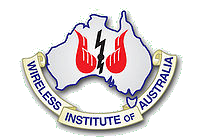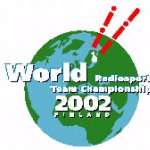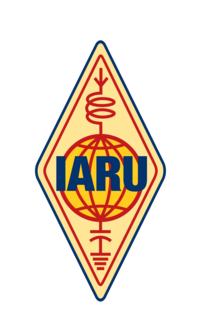Automatic Link Establishment, commonly known as ALE, is the worldwide de facto standard for digitally initiating and sustaining HF radio communications. ALE is a feature in an HF communications radio transceiver system that enables the radio station to make contact, or initiate a circuit, between itself and another HF radio station or network of stations. The purpose is to provide a reliable rapid method of calling and connecting during constantly changing HF ionospheric propagation, reception interference, and shared spectrum use of busy or congested HF channels.
The American Radio Relay League (ARRL) is the largest membership association of amateur radio enthusiasts in the United States. ARRL is a non-profit organization, and was co-founded on April 6, 1914, by Hiram Percy Maxim and Clarence D. Tuska of Hartford, Connecticut. The ARRL represents the interests of amateur radio operators before federal regulatory bodies, provides technical advice and assistance to amateur radio enthusiasts, supports a number of educational programs and sponsors emergency communications service throughout the country. The ARRL has approximately 161,000 members. In addition to members in the US, the organization claims over 7,000 members in other countries. The ARRL publishes many books and a monthly membership journal called QST.

The Wireless Institute of Australia (WIA) was formed in 1910, and is the first and oldest national amateur radio society in the world. It represents the amateur radio operators of Australia as the AR "peak body" in dealings with the Australian Communications and Media Authority (ACMA), the authority under the government of Australia that administers communications within and external to Australia. The WIA publishes a bi-monthly journal for its membership called Amateur Radio. The organisation is the national society representing Australia in the International Amateur Radio Union.

Radio Amateurs of Canada (RAC), known in French as Radio Amateurs du Canada, is the national association for Amateur Radio in Canada. It is a not-for-profit membership association with headquarters in Ottawa, Ontario, Canada, representing the interests of Amateur Radio all across Canada. Speaking on behalf of Canadian Radio Amateurs, RAC provides liaison with government agencies and carries the Amateur voice about regulatory and spectrum issues to the discussion table with government and industry leaders, nationally and internationally.

The 20-meter or 14-MHz amateur radio band is a portion of the shortwave radio spectrum, comprising frequencies stretching from 14.000 MHz to 14.350 MHz. The 20-meter band is widely considered among the best for long-distance communication (DXing), and is one of the most popular—and crowded—during contests. Several factors contribute to this, including the band's large size, the relatively small size of antennas tuned to it and its good potential for daytime DX operation even in unfavorable propagation conditions.

Contesting is a competitive activity pursued by amateur radio operators. In a contest, an amateur radio station, which may be operated by an individual or a team, seeks to contact as many other amateur radio stations as possible in a given period of time and exchange information. Rules for each competition define the amateur radio bands, the mode of communication that may be used, and the kind of information that must be exchanged. The contacts made during the contest contribute to a score by which stations are ranked. Contest sponsors publish the results in magazines and on web sites.

Radiosport is formal competition among amateur radio operators in any of three amateur radio activities, ARDF, DXing, and Contesting. The Friendship Radiosport Games is an international multi-sport event that includes all three types of radiosport. Since 1977, the International Amateur Radio Union has sponsored the IARU HF World Championship. The World Radiosport Team Championship is another international competition.

Amateur radio direction finding is an amateur racing sport that combines radio direction finding with the map and compass skills of orienteering. It is a timed race in which individual competitors use a topographic map, a magnetic compass and radio direction finding apparatus to navigate through diverse wooded terrain while searching for radio transmitters. The rules of the sport and international competitions are organized by the International Amateur Radio Union. The sport has been most popular in Eastern Europe, Russia, and China, where it was often used in the physical education programs in schools.

In times of crisis and natural disasters, amateur radio is often used as a means of emergency communication when wireline, cell phones and other conventional means of communications fail.
The South African Radio League (SARL), formerly known as the South African Radio Relay League (SARRL), is a non-profit organisation representing the interests of amateur radio enthusiasts in South Africa. The SARL advocates on behalf of its membership and all licensed amateur radio operators in South Africa as the representative of amateur radio to the South African government. This has included the promotion of deregulation and simplification of the amateur radio service, and expansion of the number of amateur radio operators in Southern Africa. The SARL publicises and promotes the role of amateur radio in society, and promotes the use of amateur radio in schools as an entry point into the fields of science and technology. The SARL publishes a magazine called Radio ZS twelve times a year. SARL is the national Member Society representing South Africa in the International Amateur Radio Union and is a Member Society in IARU Region 1.
The World Administrative Radio Conference (WARC) bands are three portions of the shortwave radio spectrum used by licensed and/or certified amateur radio operators. They consist of 30 meters (10.1–10.15 MHz), 17 meters (18.068–18.168 MHz), and 12 meters (24.89–24.99 MHz). They were named after the World Administrative Radio Conference, which in 1979 created a worldwide allocation of these bands for amateur use. The bands were opened for use in the early 1980s. Due to their relatively small bandwidth of 100 kHz or less, there is a gentlemen's agreement that the WARC bands may not be used for general contesting. This agreement has been codified in official recommendations, such as the IARU Region 1 HF Manager's Handbook, which states: "Contest activity shall not take place on the 5, 10, 18 and 24 MHz bands."

The Global Amateur Radio Emergency Communications Conference or GAREC is a yearly conference held by the International Amateur Radio Union for discussion of amateur radio operation during natural disasters and other emergencies with the motto, "Saving lives through emergency communications". GAREC was first held in Tampere, Finland in 2005, coinciding with the adoption of the Tampere Convention, a globally binding emergency communications treaty that had been signed in Tampere in 1998. In later conferences, the venue has attempted to rotate in sequence through ITU Regions 1, 2 and 3.
The Tampere Convention is a multilateral treaty governing the provision and availability of communications equipment during disaster relief operations, particularly as regards the transport of radio and related equipment over international boundaries by radio amateurs. It was concluded at the First Intergovernmental Conference on Emergency Telecommunications (ICET-98) in Tampere, Finland, in 1998, and went into effect on 8 January 2005. As of September 2014, there are 48 state parties to the agreement.
The Chinese Radio Sports And Orienteering Association (CRSAOA) is a national non-profit organization for amateur radio enthusiasts in the People's Republic of China. The CRSA's primary mission is to popularize and promote amateur radio in China. Early activities of the organization focused on radiosport, and the CRSA was active in promoting Amateur Radio Direction Finding and High Speed Telegraphy competitions throughout the country. Although the CRSA has broadened its scope and now supports many kinds of radio activities, the organization's name continues to reflect this early heritage. Key membership benefits of the organization include QSL bureau services, a quarterly membership magazine called Ham's CQ. CRSA was also responsible for the administration of the amateur radio license certification program in the People's Republic of China until 2010.Former Chinese Radio Sports Association.
The Radioamateurs du Luxembourg (RL), originally founded in 1937 as Réseau Luxembourgeois des Amateurs d'Ondes Courtes, is a national non-profit organization for amateur radio enthusiasts in Luxembourg. RL supports amateur radio operators in Luxembourg by operating the RL QSL Bureau for those members who regularly communicate with amateur radio operators in other countries, sponsoring amateur radio operating awards and radio contests, and supporting radio propagation beacons in Luxembourg. RL represents the interests of amateur radio operators in Luxembourg before local and international telecommunications regulatory authorities. RL is the national member society representing Luxembourg in the International Amateur Radio Union.
The Bangladesh Amateur Radio League (BARL) is a national non-profit organization for amateur radio enthusiasts in Bangladesh. BARL is the national member society representing Bangladesh in the International Amateur Radio Union, which it joined in 1982.
The Kazakhstan Federation of Radiosport and Radio Amateur is a national non-profit organization for amateur radio enthusiasts in Kazakhstan. KFRR promotes amateur radio in Kazakhstan by sponsoring amateur radio operating awards and radio contests. The KFRR organizes and supports Amateur Radio Direction Finding competitions and the Kazakhstan national ARDF team. The KFRR also represents the interests of Kazakhstan amateur radio operators before Kazakhstan and international telecommunications regulatory authorities. KFRR is the national member society representing Kazakhstan in the International Amateur Radio Union, which it joined on February 10, 2009.

Amateur radio, also known as ham radio, is the use of the radio frequency spectrum for purposes of non-commercial exchange of messages, wireless experimentation, self-training, private recreation, radiosport, contesting, and emergency communications. The term "amateur" is used to specify "a duly authorized person interested in radioelectric practice with a purely personal aim and without pecuniary interest"; and to differentiate it from commercial broadcasting, public safety, or professional two-way radio services.
The 630-meter amateur radio band is a frequency band allocated by the International Telecommunication Union (ITU) to amateur radio operators, and it ranges from 472–479 kHz, or equivalently 625.9–635.1 meters wavelength. It was formally allocated to amateurs at the 2012 World Radiocommunication Conference (WRC-12). The band is available on a secondary basis in all ITU regions with the limitation that amateur stations have maximum radiated power of 1 watt effective isotropic radiated power (EIRP); however, stations more than 800 km from certain countries may be permitted to use 5 watts EIRP.
Call signs in United Kingdom include a three letter country code, and a series of letters and numbers.











